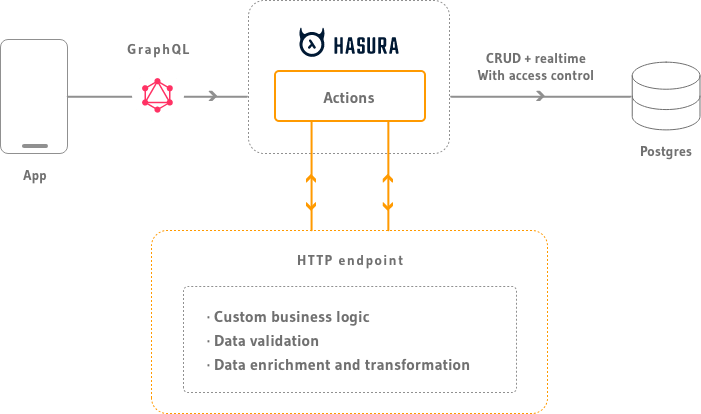Actions¶
Table of contents
What are actions?¶
Actions are a way to extend Hasura’s schema with custom business logic using custom queries and mutations. Actions can be added to Hasura to handle various use cases such as data validation, data enrichment from external sources and any other complex business logic.

Supported from
Actions are supported in Hasura GraphQL engine versions v.1.2.0 and above.
Actions are supported for Postgres versions 10 and above.
Action description¶
An action consists of the following parts:
Type: The type of the action (queryormutation)Definition: The definition of the query or mutationHandler: The logic to be run when the query or mutation is executedKind: Sync or async. In case of a query action, there is noKindassociated with it. A query action is always sync
Type¶
Actions can be of two types:
- Query action: An action of type
queryextends the query root of the Hasura schema. This means that you can execute this action through a GraphQL query. Query actions must be used where you want to fetch data from a data source without changing anything on the data source. - Mutation action: An action of type
mutationextends the mutation root of the Hasura schema. This means that you can execute this action through a GraphQL mutation. Mutation actions must be used when you want to mutate the state of a data source and fetch some data.
Definition¶
The action definition consists of the following:
Action Name: The action will be available as a query or mutation in the GraphQL schema named as the action nameArguments: Arguments are used to pass dynamic values along with the query/mutation.Response type: The GraphQL type of the response that the query or mutation will return. Actions can only return object types.
For instance, consider this action definition:
extend type Mutation {
userLogin(username: String!, password: String!): UserInfo
}
In this definition, we are extending the mutation root with an action called
userLogin.
userLoginis the action nameusernameandpasswordare the arguments that accept non-nullable string values.UserInfois the response type of the action
Custom Types
An action must return an object type. This means, you will have to define your custom types like so:
type UserInfo {
accessToken: String!
userId: Int!
}
Read more about custom types.
Handler¶
Once you define the action types, you also have to specify the logic to run when the action is executed. This can be done in an HTTP webhook, also called the action handler. It could be a REST endpoint or a serverless function.
Learn more about writing an action handler.
Kind¶
Mutation actions are of two kinds:
- Synchronous: Sync actions return a response to the client after receiving a response from the handler.
- Asynchronous: Async actions return an
action idas response to the client before receiving a response from the handler and allow the client to subscribe to the actual response using theaction id.
Query actions don’t have a kind, they always behave like sync mutation actions.
How it works?¶
- Hasura receives the action GraphQL query or mutation and converts this request into an event payload.
- The event is captured, persisted and then delivered to the action handler with the appropriate retry/delivery guarantees.
- The action handler runs and returns a response that is captured as an event and again persisted to the event store.
- The action response is returned to the client synchronously or asynchronously based on the kind.
Actions vs. remote schemas¶
Both actions and remote schemas can be used to extend Hasura with business logic. However, they have slightly different use cases.
Actions
Actions can be used when we want to call a REST endpoint from Hasura as a resolver for some custom types. They are especially useful for setting up serverless functions as resolvers.
Remote schemas
If you have an existing GraphQL API or if you’re comfortable building a GraphQL server yourself, you can use remote schemas to add custom types and resolvers.
